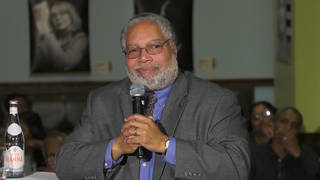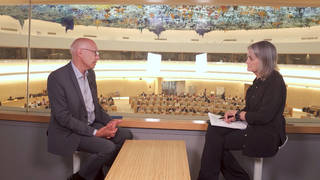
Guests
- Jan Leeco-founder of Neighbors United Below Canal, a community group opposed to the construction of a new jail in Lower Manhattan.
- Christopher Martemember of New York City Council representing District 1.
- Jon Alpertco-founder and co-executive director of DCTV, located in New York’s Chinatown.
Residents of New York’s Chinatown are speaking out against the construction of a new megajail in the neighborhood that would be a third as high as the Empire State Building, which would likely make it the tallest jail in the world, if finished. The so-called jailscraper is part of an $8 billion plan to build new jails across the city in order to retire the infamous Rikers Island facility, but opponents say that money would be better spent on social services, harm reduction and other initiatives that would better serve the community. Jan Lee, co-founder of the community group Neighbors United Below Canal, says Chinatown residents are interested in “creating a more humane environment for those who are incarcerated.” We also speak with Christopher Marte, who represents the area on New York City Council, and Jon Alpert, co-founder of the community media center DCTV, based in Chinatown for half a century, who has been documenting the struggle.
Transcript
AMY GOODMAN: This is Democracy Now!, democracynow.org, The War and Peace Report. I’m Amy Goodman, as we look now at the fight to stop the construction of what could be the world’s tallest jail, in Chinatown, the neighborhood of Manhattan. The 300-foot-tall so-called jailscraper or megajail would be a third as high as the Empire State Building. It’s one of four new jails that are part of a plan to replace the city’s notorious Rikers Island jail, where 18 prisoners have died this year alone.
The Marshall Project reports the borough-based jail plan focuses on building near courthouses and would feature jails meant to be more, quote, “humane.” Opponents of the $8 billion plan, including the No New Jails Coalition, have called instead for the city to invest in noncarceral violence prevention, harm reduction and crisis management.
In addition to the jailscraper in Manhattan, the city’s plan includes new jails in Queens, Brooklyn and the Bronx. It excludes Staten Island, predominantly white and conservative.
Chinatown is one of New York City’s poorest neighborhoods, with more than a quarter of residents living in poverty, including a third of senior citizens. In March, hundreds snaked through Chinatown’s busy streets and formed a human chain to protest the jail. This is a clip from the short documentary Jailscraper vs. Chinatown by the award-winning filmmaker Jon Alpert, co-founder of DCTV, which has been located in Chinatown for half a century, the former home of Democracy Now! The direct action was organized by Neighbors United Below Canal. This is the co-founder, who will join us in a minute.
JAN LEE: We are not letting you put up these fences. We’re going to defend Chinatown. We’re going to do this civil disobedience to block this truck. Everybody, sit down. Any company that comes to Chinatown to profit off of the building of this jail or the demolition of these two jails is not welcome in Chinatown or Little Italy. You are not welcome here.
PROTESTERS: People first, no new jails! People first, no new jails! People first, no new jails! People first, no new jails!
SUSAN LEE: We’re doing it for our community! We’re doing it for our seniors! Right behind you is a senior living center. We’re doing it for them. We’re doing it for the residents.
PROTESTER: Yes!
EVELYN YANG: Over 12,000 letters written to Mayor Adams against this jail. We have heard zero response from his administration. How dare he not even respond to his constituents!
AMY GOODMAN: The protesters mentioned New York City Mayor Eric Adams, who took office in January, has continued to support the jail plan he inherited from Mayor Bill de Blasio, despite Adams vowing to stop it when he was on the campaign trail. This is then-candidate Eric Adams speaking in April of 2021 in Chinatown.
ERIC ADAMS: I know this community well. As a police officer, I was assigned in this community. I know how much they have endured. And so, if we want to stop the thoughtlessness that goes into what this community has experienced with the recent level of hate crimes, let’s stop the institutionalizing of the hate that we’re seeing in government. So I join them today in saying no new jail, no building up a jail in this location. We can do a better job.
AMY GOODMAN: That was then-candidate Eric Adams. Over the weekend, construction heated up on the jailscraper in Chinatown even as opposition continues. Just before we went to broadcast, filmmaker Jon Alpert recorded this update from DCTV’s Mike Kimber. It’s just feet from the jail.
MIKE KIMBER: Tearing up the street, and they was tearing it up for the jail. And our basement flooded out with water and mud in the basement, because this is a low point of the block. And all our basement got flooded up.
JON ALPERT: From the jail construction.
MIKE KIMBER: From the jail — yeah, from the jail construction. That’s the reason they’re tearing this up, is all because of the jail. And they just put this brand-new street down in August for Summer Streets. And they tore it all back up.
AMY GOODMAN: Democracy Now! invited [a city representative to join us. A spokesperson from the NYC Department of Design and Construction sent us this statement]: “All four jail sites are currently either in demolition to remove existing structures or in site preparation to prepare for construction. We continue to carry out the Borough-Based Jails program every day,” they wrote.
Well, for more, we’re joined by three guests. Jan Lee, who you just heard in that video, is the co-founder of Neighbors United Below Canal. Christopher Marte is a New York City councilmember representing District 1, which includes Chinatown. He has been at the protests. And Jon Alpert, who has won more Emmys than we can count, is a journalist and documentary filmmaker, co-founder and executive director of DCTV, along with Keiko Tsuno.
We welcome you all to Democracy Now! Jan, let’s begin with you. Jan Lee, you have been fighting this jailscraper. We’re talking about a prison [sic] that would be the tallest in the world? What involvement has the community had in this? And has it broken ground?
JAN LEE: Well, we have to be — we have to make a distinction here: It’s not a prison, it is a jail. This is intended for detention pretrial and some short-term stays.
Let’s be clear about the history of Chinatown. We have had a jail at that site since 1838, so we are very familiar with how the city, with varying administrations, has torn down jails and built bigger ones in their place. And every time that they’ve built a bigger one, they were just as dysfunctional as the ones before them. And so, what we’re saying is we’re in a very unique position as a community that has fully accepted our part in creating a more humane environment for those who are incarcerated. It’s very important to understand that, that we are accepting of this.
What we’re not accepting is the sacrifice, because this is a very dangerous area to be building a 350 — it’s not 300, it’s 350-foot-tall, tallest jail in the world. It’s also the massive — this building is a couple of blocks long in every direction. So, we still don’t know what it looks like. The plans have not been revealed. They won’t be revealed for quite a while, because this is a design-build project. So, contrary to what a lot of people say about Chinatown being NIMBY, we’re not at all. We’re fully accepting a jail at this site, and —
AMY GOODMAN: When you say ”NIMBY,” you mean “not in my backyard.”
JAN LEE: Yeah, yeah, and that’s just an unfair characteristic of our fight, that has gone on since 2018, over the jail being torn — these two jails being torn down and a new megajail being built in its place. We actually sit — Chinatown sits in the largest carceral footprint probably on the whole East Coast of the United States, with every court represented, a federal jail and two city jails.
AMY GOODMAN: Jon Alpert, you just filmed Mike Kimber outside the DCTV, a place we know well. We broadcast from there for years. Explain what is happening directly next door to you. And what have you been told? How are you preparing for this building of the jail? And is it a fait accompli?
JON ALPERT: Well, the city is rushing to — yeah, the city is rushing to make it a fait accompli, because if they can knock something down, then it’s too late to do what we’re suggesting, is to adapt the current jails that we have right now and modernize them. That will be so much cheaper. You know, right here, this is sort of instructive. Between me and Chris is the part of the Empire State Building that’s the exact size of the jail that they’re trying to build. The Empire State Building cost about $40 million. Just to tear down, what they’re doing right now, $250 million. They haven’t built any housing. When was the last time they built housing in our neighborhood?
COUNCILMEMBER CHRISTOPHER MARTE: Thirty-five years.
JON ALPERT: OK. No new hospitals. The schools are missed. All the money that we need to spend on giving opportunities to people is being spent on iron bars, and it’s being spent on a building that is — nobody’s ever seen anything like this before. And it’s pork barrel. It’s absolute pork barrel. It’s sort of ironic that it’s right up the street from the Tweed courthouse, but this makes the Tweed courthouse look like a pup tent.
AMY GOODMAN: You’re talking about Boss Tweed, the famous corrupt politician of New York City. Well, Christopher Marte, you’re the New York City councilmember who represents the district. What do you understand? Now, this is — is this going to be a third as high as the Empire State Building or as high as the Empire State Building? And what involvement does — you’re an elected representative — does your community have?
COUNCILMEMBER CHRISTOPHER MARTE: Yeah. So, it’s going to be a third of the Empire State Building. And as Jan mentioned, for the past four years we have been organizing, testifying, even suing the city to stop the construction of the world’s tallest jail.
And leaders of our community, like Jan and myself, have come together and met with the administration a number of times throughout this year to convince them of adaptive reuse. Right now in Rikers Island, almost every single month we hear about another death. We hear about the inhumane nature that’s happening there. We have a plan that will allow you to adaptively reuse the two current jails to house these people much quicker, closer to the court and closer to their families. Plus, this is going to save the city almost a billion dollars. Right now they’re over budget when it comes to the building and the demolition of this site.
And so, we have a plan that’s supported by our entire community. As Jan said, we have lived with this ecosystem for decades. And we want to make sure that the city listens to us. And we will continue on fighting to make sure that we are heard.
AMY GOODMAN: So, just to be clear, you’re saying you support the closing of Rikers, but you don’t support what’s being done as the alternative. If you can elaborate on what Jon Alpert just talked about, where money is spent in the city. For example, the issue of housing and hospitals, healthcare. And the two jails you’re talking about are the two jails right there right now, right? One of them used to be called what? The Bernard Kerik Detention Complex, until Bernard Kerik, the former police commissioner, was put in the prison, and so — the jail, and so then they removed that banner?
COUNCILMEMBER CHRISTOPHER MARTE: Yeah, and now it’s called the Tombs, which is really ironic, as well.
For me, this is personal. My brother was in and out of Rikers Island growing up. I have been there a number of times. I’ve taken my nephew, when he was a child, up there and seen the inhumane nature for everyone involved in that.
And right now with the construction of this new megajail, the city wouldn’t even release plans of what it’s going to look like, the programming in it. And throughout this whole process, there hasn’t been any transparency or any accountability.
It has taken us, the community, to develop our own plan to build a much humane project that’s going to be quicker, save money and move people off Rikers Island much quicker. And so, we’ve been pushing forward this plan to make sure that we can have a say in this process.
AMY GOODMAN: So, Jan Lee, there used to be many more community groups who were very vocally opposed to this. What’s happened?
JAN LEE: Well, Neighbors United Below Canal was formed with Chris and myself and some other community leaders as a clearinghouse of information, because the information that we get from the city involved in the Uniform Land Use Review Process is extremely complex. And the community partners that we partner with have used NUBC as the front face of this opposition.
But we should also look toward the positive nature of what an adaptive reuse can be and why people should support it. We’re looking at not a renovation. A renovation is just a cursory, rudimentary redo of something. We’re talking about an entire stripdown of these buildings, down to the steel girders, and building back these buildings with more efficient use of space, all to code, and making it a beautiful and more humane environment for the people who are going to be inside.
We’re also looking at something that could be a shining beacon for the future of New York City and Lower Manhattan to look at how we have taken what used to be, since 1838, failed policies over and over again at that site, and really create something that the neighborhood could be proud of and still maintain a safe building, not having to dig down many, many feet into what is essentially a swamp. And what they’ve experienced at DCTV is flooding. Well, that’s because the water table is very close to the surface. This is not an area where you want to build a jailscraper. It’s not an area where the soil is stable. We will destabilize Chinatown, both psychologically, economically, financially. We’re still on the heels of many other disasters, like 9/11 and Hurricane Sandy, and, of course, the global pandemic.
We should be reminded also that this plan was planned in 2017, when things were a lot different. We’re looking at the heels of a global pandemic, which has set back supply chain issues, costs of building. And don’t we want to be more green? Shouldn’t we not take buildings down and put them into landfills? There’s a way to do this that the world, the rest of the world, has really adopted, which is adaptive reuse. And I really think that we can look forward to a win-win situation for both the administration, the detainees and for the neighborhood, that won’t be subject to these years-long demolition and years-long construction. We can get people into safer environments much, much faster.
AMY GOODMAN: So, Jon Alpert, the land — the bridge between the two buildings was taken down. Are there permits for this destruction? How were you informed about all of this in the community?
JON ALPERT: So, they’ve knocked the windows out of the bridge. As we were coming up here today, they had the instruments of destruction ready to bash it down. They’re trying to get something down as fast as they can, so that it’s fait accompli and they’ve got to take the whole building down.
But the sad situation is that there isn’t rationality involved. Nobody is thinking what’s really best for the city. It’s how much money they can spend as fast as possible. This is the perfect definition of pork barrel. Nobody is thinking about judicial justice. They put the sheep’s clothing of judicial justice on this project. It’s just pork barrel. And it’s to funnel money, unfortunately, away from what our city really, really needs into iron bars. It is as regressive as anything that’s ever been done in the history of New York City. And it’s shocking that some of the political leaders are going along with this. But, you know, one of the things that has made this happen is —
AMY GOODMAN: We have 10 seconds.
JON ALPERT: — there was a — there was a lot of corruption, Amy. And people who should have opposed this got bought off. They’re doing anything they can to build this jail.
AMY GOODMAN: Chris Marte, is it possible to change this?
COUNCILMEMBER CHRISTOPHER MARTE: Yeah. So, regarding the permits, there aren’t permits to demolish these buildings, just the bridge. And as we saw a few weeks ago, they are —
AMY GOODMAN: We have to leave it there, Chris Marte, Jon Alpert and Jan Lee. I’m Amy Goodman. Thanks for joining us.












Media Options